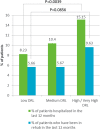Alcohol Dependence, Co-occurring Conditions and Attributable Burden
- PMID: 26246514
- PMCID: PMC4755551
- DOI: 10.1093/alcalc/agv088
Alcohol Dependence, Co-occurring Conditions and Attributable Burden
Abstract
Aims: Alcohol dependence is associated with high rates of co-occurring disorders which impact health-related quality of life (HRQoL) and add to the cost-of-illness. This study investigated the burden of alcohol dependence and associated co-occurring conditions on health and productivity.
Methods: A cross-sectional survey was conducted in eight European countries. Physicians (Psychiatrists and General Practitioners) completed patient record forms, which included assessment of co-occurring conditions, and patients completed matching self-completion forms. Drinking risk level (DRL) was calculated and the relationship between DRL, co-occurring conditions, work productivity, hospitalisations and rehabilitation stays was explored.
Results: Data were collected for 2979 alcohol-dependent patients (mean age 48.8 ± 13.6 years; 70% male). In total, 77% of patients suffered from moderate-to-severe co-occurring psychiatric and/or somatic conditions. High DRL was significantly associated with depression, greater work productivity losses, increased hospitalisations and rehabilitation stays. Co-occurring conditions were significantly associated with poorer HRQoL and decreased work productivity, with a statistical trend towards an increased frequency of rehabilitation stays.
Conclusions: Alcohol-dependent patients manifest high rates of co-occurring psychiatric and somatic conditions, which are associated with impaired work productivity and HRQoL. The continued burden of illness observed in these already-diagnosed patients suggests an unmet need in both primary and secondary care.
© The Author 2015. Medical Council on Alcohol and Oxford University Press. All rights reserved.
Figures
Similar articles
-
Co-occurring psychiatric disorders and alcoholism.Handb Clin Neurol. 2014;125:573-88. doi: 10.1016/B978-0-444-62619-6.00033-1. Handb Clin Neurol. 2014. PMID: 25307597 Review.
-
Co-occurring mental and somatic diagnoses of alcohol dependent patients in relation to long-term aftercare alcohol abstinence and well-being.Psychiatr Danub. 2008 Jun;20(2):194-207. Psychiatr Danub. 2008. PMID: 18587290
-
[Mental disorders in general hospital patients].Psychiatr Danub. 2006 Dec;18(3-4):183-92. Psychiatr Danub. 2006. PMID: 17099609 German.
-
The impact of psychiatric and extraintestinal comorbidity on quality of life and bowel symptom burden in functional GI disorders.Neurogastroenterol Motil. 2014 Sep;26(9):1323-32. doi: 10.1111/nmo.12396. Epub 2014 Jul 29. Neurogastroenterol Motil. 2014. PMID: 25070610
-
[Alcohol consumption in patients with psychiatric disorders: assessment and treatment].Encephale. 2014 Sep;40(4):301-7. doi: 10.1016/j.encep.2014.07.008. Epub 2014 Aug 8. Encephale. 2014. PMID: 25113419 Review. French.
Cited by
-
Prevalence, Demographic, and Clinical Correlates of Comorbid Depressive Symptoms in Chinese Psychiatric Patients With Alcohol Dependence.Front Psychiatry. 2020 Jun 3;11:499. doi: 10.3389/fpsyt.2020.00499. eCollection 2020. Front Psychiatry. 2020. PMID: 32581875 Free PMC article.
-
A transdiagnostic dimensional approach towards a neuropsychological assessment for addiction: an international Delphi consensus study.Addiction. 2019 Jun;114(6):1095-1109. doi: 10.1111/add.14424. Epub 2018 Oct 5. Addiction. 2019. PMID: 30133930 Free PMC article.
-
Implementing primary healthcare-based measurement, advice and treatment for heavy drinking and comorbid depression at the municipal level in three Latin American countries: final protocol for a quasiexperimental study (SCALA study).BMJ Open. 2020 Jul 28;10(7):e038226. doi: 10.1136/bmjopen-2020-038226. BMJ Open. 2020. PMID: 32723746 Free PMC article. No abstract available.
-
The Association of P300 Components With Clinical Characteristics and Efficacy of Pharmacotherapy in Alcohol Use Disorder.Front Psychiatry. 2022 Mar 30;13:770714. doi: 10.3389/fpsyt.2022.770714. eCollection 2022. Front Psychiatry. 2022. PMID: 35432013 Free PMC article.
-
Assessment of depression-like behavior and anhedonia after repeated cycles of binge-like ethanol drinking in male C57BL/6J mice.Pharmacol Biochem Behav. 2018 May;168:1-7. doi: 10.1016/j.pbb.2018.03.006. Epub 2018 Mar 15. Pharmacol Biochem Behav. 2018. PMID: 29550387 Free PMC article.
References
-
- Anderson P, Baumberg B (2006) Alcohol in Europe, A Public Health Perspective: A Report for the European Commission. London: Institute of alcohol studies.
-
- Anderson P, Gual A, Colom J (2005) Alcohol and primary health care: clinical guidelines on identification and brief interventions. Barcelona: Department of Health of the Government of Catalonia.
-
- Babor TF, Higgins-Biddle JC, Saunders JB et al. (2001) The alcohol use disorders identification test Guidelines for use in primary care, 2nd edition, Geneva: World Health Organization.
Publication types
MeSH terms
LinkOut - more resources
Full Text Sources
Other Literature Sources
Medical



